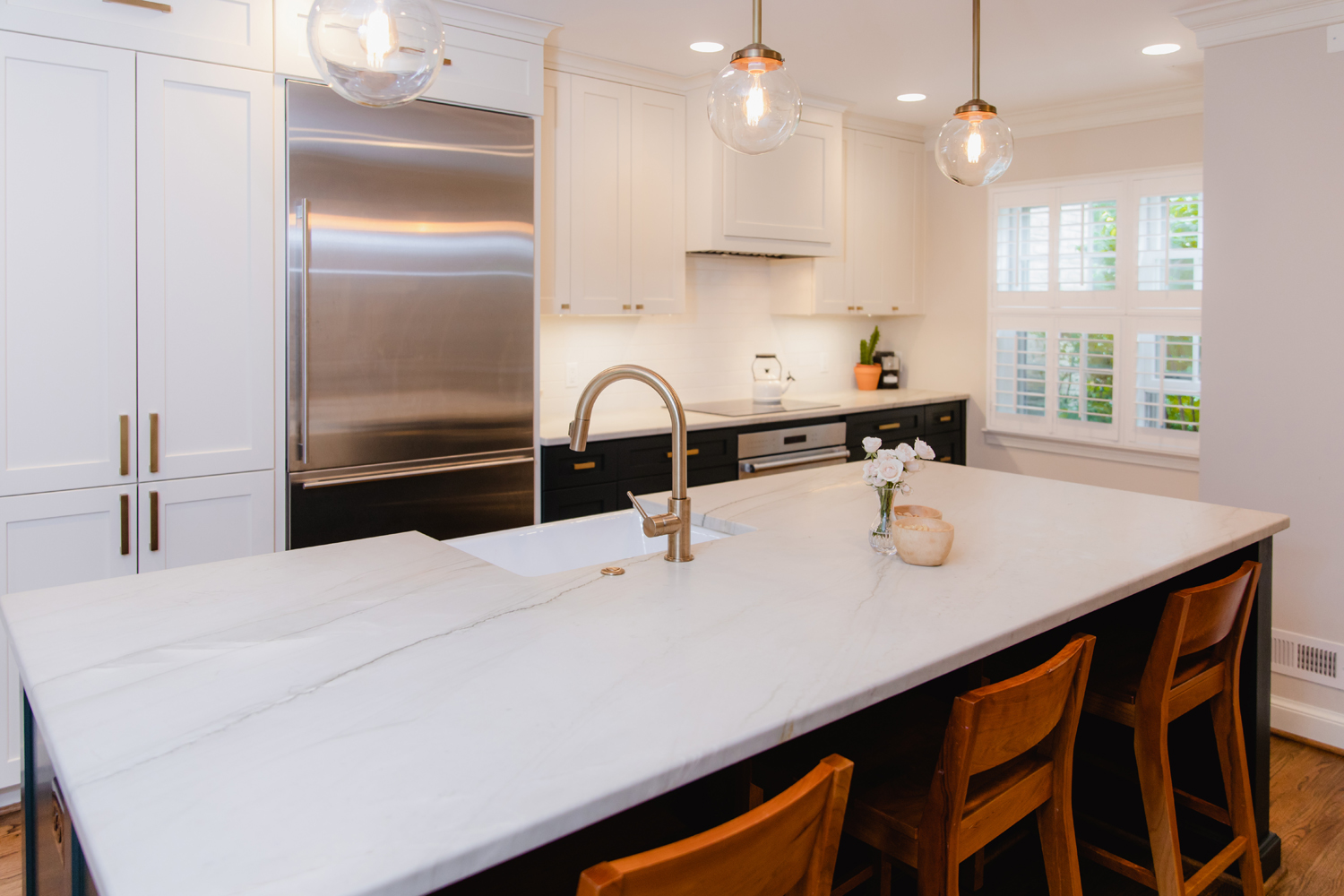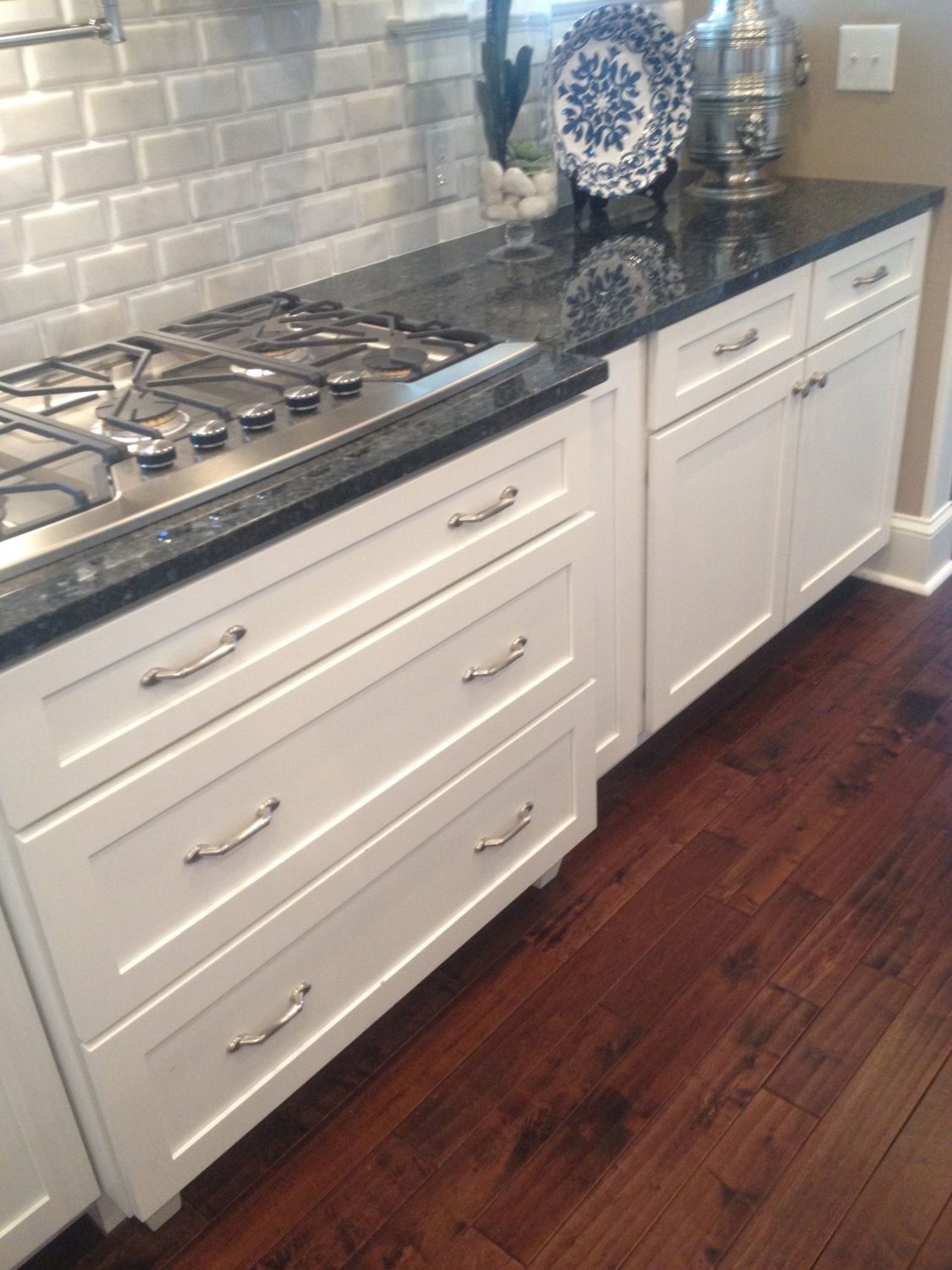Dreaming of a new, well-designed kitchen with ample storage and lustrous countertops? Many stylish features personalize a kitchen’s luxurious design, and among the most elegant are natural stone countertops. But, how do you decide between two of the most popular natural stones: elegant marble or bold granite? Hammer’s designers can help you choose design selections and a countertop that will serve as a statement piece in your beautiful kitchen remodel.
Both marble and granite are highly sought-after options for your kitchen countertops, so what should you consider when making a decision? It all depends on your aesthetic design vision, how much maintenance you are willing to do, your needs in the kitchen, and your budget. Hammer’s designers have compiled a list of similarities and differences and key factors to consider when choosing between marble and granite countertops in the kitchen or bathroom.
At A Glance: Pros and Cons of Granite and Marble Countertops
Marble and granite are heavy, hard, smooth, heat-resistant, and scorch-proof surface materials that are offered in a broad array of colors and patterns.
Positives:
| Marble | Granite |
| Elegant Vein Pattern | Less Maintenance |
| Long, Fluid Lines | Less Expensive |
| Variety of Colors and Styles | Many Colors and Styles |
| Extremely Durable |
Considerations:
| Marble | Granite |
| More Expensive | Varied Composition Between Slabs |
| Susceptible to Staining from Acids | Potential to Stain from Oil |
| Can Scratch because Softer Material | Finish Can Scratch |
| More Porous | |
| Requires More Maintenance |
The Appearance of Marble and Granite Countertops
Marble characteristics typically feature long and fluid veining; this veining is produced from marble’s prior form of limestone being transformed under intense heat and pressure due to tectonic shifting in the Earth’s crust, which altered its crystalline structure.
Granite has a more fleck-like, granular appearance. Because granite is an igneous rock, once molten and formed as it cooled deep within the Earth, it has more fleck-like specs that are varied in color throughout its surface.
Natural stone is categorized into two composition types: calcareous stone and siliceous stone.
Calcareous stone is sensitive to acids like lemon juice, vinegar, wine, citrus fruits, and vegetables as well as cleaning products and, thus, stain quite easily. Because it’s mainly calcium carbonate, calcareous stone, such as marble, travertine, limestone, and onyx, requires different cleaning products than siliceous stone.
Siliceous stone tends to be easy to clean and to maintain and is more durable because it is composed mainly of silica, or quartz-like particles. Within this category are granite, slate, and sandstone.
Color, Sheen, and Texture Differences
The color in marble is fairly consistent with long, fluid, deeper-in-color veins running through the slab that concentrates the color in the pattern. Marble comes in a wondrous display of hues, including white, black, and a range of rose, yellow, green, and gray color spectrums. A gray-blue slab of marble may have striking, darker blue veins that contrast beautifully. When installed with the striations of veins composed of minerals running horizontally, it presents the illusion of a wider space.
The biggest difference between marble and granite is the natural stone’s porosity. Marble is softer than granite and more porous, except marble from Danby, Vermont. Marble tends to be polished and rarely honed, or unpolished; a polished sheen can provide a very sleek and extravagant look to your kitchen.
No two slabs of marble or granite are the same, so your kitchen design will feature unique countertops or backsplashes. For this reason, it’s essential to hand-select your slabs yourself at the natural stone yard or fabricator to ensure the color and appearance are inclusive of your design vision.
A granite slab may contain a variety of hues in medium to dark shades, including blue, green, orange, pink, red, browns, beige, gray, and black. The grains in granite create depth and a more compact appearance. For a dramatic design in the kitchen, black and gray granite countertops are best suited for contemporary kitchens that feature light wood or white cabinets.
In addition to a variety of color options, granite fabricators now offer textured surface treatments, including a ‘leathered’ finish that is gaining more traction in the design world. Most often applied to darker stones, leathering adds subtle, dimple-like texture and looks magnificent with a soft honed-sheen finish. For granite that features larger patterns, the leathered treatment creates a very interesting surface with wider, not deeper, grooves in the darker material and maintains the flatness overall in the lighter-colored surface.
Similar Maintenance
Because marble and granite are natural stone materials, both are porous and will absorb liquids if not sealed properly after installation. It’s critical to seal both marble and granite at least once a year to help prevent stains from oils, acids, or colored foods. Leaving butter on the counter for a couple nights will lead to staining the natural stone. When water doesn’t pool on top of the surface but rather penetrates it, means it’s time to reseal your natural stone. Marble is especially vulnerable, so it’s a good idea to keep oils and wines stored off the countertop or on a coaster or tray, and the same is true for using trivets for piping hot dishes from the oven.
Although both marble and granite are durable, granite is the strongest of all the natural stone options, so it’s more resistant to chips, scratches, and discoloration. Marble requires moderate to high maintenance, in comparison to granite because it’s a softer material; but if both are sealed properly and spills are cleaned up quickly, they’ll last a lifetime and look beautiful forever.
Cost Comparison
Although there are a variety of countertop options available to complete your design, natural stone is a solid choice for kitchens and bathrooms. Both marble and granite are on the higher-end of cost, with marble often costing more per square foot than granite. Both require professional installation because of the weight, size, and tools required to fabricate the layout which requires seams, corners, and cutouts for a main or an island sink.
In general, marble starts at $100 per square foot installed, while granite begins at $75 per square foot installed. However, the higher-end marble options can top $200 per square foot installed, and granite options can cost $175.
Installation
Marble and granite installation by a professional begins with a template of your cabinet layout and then transferred to a slab, which is then cut and fabricated to fit around cabinet edges, corners, and sinks. The countertops are installed with the slabs set directly onto the cabinet or a plywood substrate and secured with silicone adhesive. Upon installation, confirm with your installer if the natural stone has been sealed or if you or your contractor are required to seal it immediately. Granite is often sealed once a year, while marble needs to be protected more frequently with a sealant designed for porous stone surfaces.
What are your design goals?
Your design goals will most likely drive the final decision between marble or granite countertops. Beauty is subjective, so set your eyes on a variety of options and consider the colors of your cabinets, flooring, walls, appliances, and backsplash when comparing the striation of veins in marble or the flecks of colors in granite.
Marble remains in high demand for kitchen and bathroom countertops because of its elegant good looks and because it delivers an element of class to any space in the home. On the other hand, granite continues to be the most popular of all the natural stone countertop materials because of its natural look, strength and durability, color options and patterns, and low porosity and lower maintenance. These are key considerations for a kitchen designed around active family members who enjoy playing and preparing in the kitchen with less concern for staining, scratching, or maintenance than marble.
If you can’t make a decision because you love them both, you can always choose to use one surface around the perimeter and another on the island, which helps create intrigue and contrast within the space.
Whether you choose marble or granite, both natural stones lend beauty and style to kitchen and bathroom design, are available in a broad array of colors, are customizable to fit almost any size and shape, and compliment all design styles from traditional to transitional to contemporary. If you would like to know more about marble, check out Hammer’s recent blog 5 Things to Know About Marble Countertops.









